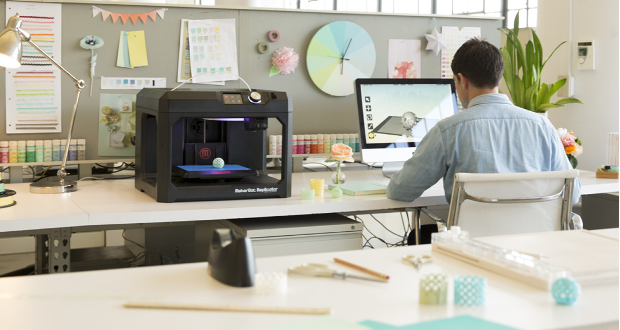3D printing, the future El Dorado of the job market?

In 2014, 3Dnatives France published a study on recruitment in the 3D printing industry with the goal of showing how technology has led to an increased demand for diverse profiles to join the industry. Recently the Orientation Council, (a body that is attached to the Institute for European Social Protection (Ipse), released a report stating that 50% of existing jobs were likely to change or even disappear due to advances being made in artificial intelligence, robotics and 3D printing. While this may seem discouraging, we wanted to see how true this was by examining how additive manufacturing can potentially help you and your future career.
In order to better understand this sector, we first needed to understand the opportunities that are currently being offered and what qualifications people are looking for during the hiring process. To do this, we decided to meet with three professionals who have a long history in this sector; who could show us what direction 3D printing is going in. Our key goal during our meetings was to find out if this sector will replace or destroy many of the job sectors that we see today in the long term.
Our three interviewees were George Fisher-Wilson, the Communications Manager at 3DHubs (a famous platform that links owners of 3D printers to potential users), Marine Coré-Baillais, the Marketing Director of Sculpteo (a French on demand 3D printing service) and Gesa Schneider, the EMEA Channel Manager at BigRep (a German manufacturer of large scale 3D printers).
Technological progress: Often Considered to be a Threat
Starting out in our study, we were quickly able to see the potential for job creation in the 3D printing industry; with an especially strong demand for specialized and technical profiles. These profiles included industrial and mechanical engineers, as well as software developers that are dedicated only to 3D printing. In the previously mentioned report by the Orientation Council, they also reaffirmed that technological progress will continue to favor those who are skilled and highly qualified in 3D printing, robotics and artificial intelligence.

Job openings related to 3D printing in the United States increased from 2010 to 2014 (source: Wanted Analytics)
But as with all good news there is some bad. One of these is that 10% of current professions found today will be threatened due to automated technologies like 3D printing. Some professions that would most likely feel a change from human to technology would be within the jewelry and craft sectors, as well as on the production line with blue-collar workers.
Skills are Needed to Work in 3D printing:
Regardless of the opportunities or threats that are posed to the current market, if you are looking for a future job in 3D printing, there are specific requirements that you must have in order to move forward within a career. To help us better understand what the requirements are and how they will evolve, we have met with some professionals who can help inform us on what you will need to begin your professional career in 3D printing.
Recruiters today are looking for several types of skills that range from engineering to design; but also a little bit more. Sculpteo’s Marketing Director Marine Coré-Baillais mentions that a thorough understaning of coding, web interface, mathematics, and modeling is a must. She explains “The demand is strongest for qualified engineers who can take on specific topics in 3D printing”.
Because the amount of knowledge required when working in the 3D printing sector is quite numerous and involves different specialties, we wanted to know how to help develop these skills for those who are looking to become future specialists. When talking to Gesa Schneider about this potential hurdle, she replied, “We need to make sure that 3D printing is included in the school system and that children learn the basics of this technology”.
It is no coincidence that more and more schools and special classes have begun popping up to help integrate 3D printing into the lives of younger generations. An example of this can be seen in China who opened a school two years ago that is dedicated solely to 3D printing.
Universities around the world have also taken notice and have begun offering classes that allow students to become more competitive in their field. Some examples of universities where you can find these classes are: the University of Queensland and the University of Wollongong in Australia, the University Center in Utrecht in Holland, and the University of Würzburg in Germany. There are also many vocational training programs that are being offered at many universities as well. These universities include MIT in the U.S. or l’école des Arts et Métiers Paris Tech in Paris, France.
Marine Coré-Baillais confirmed that training does play a decisive role in defining the future of 3D printing. “I often talk with young engineers who use 3D printing as part of their studies and are passionate for it. They’re developing a very valuable skill!”.
“A valuable skill that becomes a “key element in the STEM curriculum to help fill this skill gap that is being created”, says 3DHubs Communication Manager, George Fisher-Wilson. This shows that both education and professional training in 3D printing is making it easier to access the new trades that are being created by this technology.
3D Printing Professions:
Though we have interviewed three different people within the 3D printing sector, we were still able to receive an unanimous agreement about one thing: it is up to the education system to help pass on the knowledge necessary to help students cultivate the qualified profiles that are needed. But what kind of profiles are these exactly? Have new jobs even been created in the 3D printing industry?
Our experts’ response was quite clear: “Yes! Without 3D printing, 3DHubs would not exist. It was necessary to create the positions that you see today in 3D printing. For example, without 3D printing, there would be no need for experts in optimization nor would there be a need for 3D design software specialists. Today, we have a whole team that is responsible for this”, says Fisher Wilson. “At the company’s headquarters, we already have 40 new positions created”. When talking to Gesa at BigRep, she explained to us some of the positions that are currently held by their employees. These positions include “post-processing specialists, 3D materials experts, consultants, or specialists in 3D designing”.
Sculpteo also employs software engineers who work on specific problems that are found in 3D printing, such as: repairing 3D files, building optimization tools and making the link between orders, the management of machines and production. “We have built and continue to build in-house, a panel of important tools that are all specific to 3D printing”.
What sectors are recruiting for 3D printing?
During the course of our interviews, our interviewees all emphasized that this technology is a step towards the future. Based on this, we were intrigued to find out our their thoughts on which industries this technology would be integrated into even more than is currently seen.
3DHubs is betting on seeing a growing demand in the medical and engineering sectors, a field who has already begun furthering their research on materials and new technologies. These advances could offer new opportunities that help to accelerate the adoption of 3D printing technology into these sectors, thus increasing the need for more qualified professionals.
Other sectors that are recruiting professionals for 3D printing, according to BigRep, are the automotive and aerospace industries, where they are currently looking for ways to produce parts more efficiently for vehicles and aircrafts. When taking into account that additive manufacturing can significantly reduce the weight of required parts, the costs, and fuel consumption, it’s an obvious choice for most manufacturers today. Therefore, a potential increase in recruitment of qualified persons in these fields can be expected.
The list of sectors that will recruit is not a list that can be finished anytime soon. 3D printing is based on a long term view and because of this, there is no clear cut path that is set. With the constant improvements and break throughs each day, there is no telling what sectors will or will not be touched by this technology in the future. This is a feeling that is shared by each of our experts
Is 3D Printing Really a Threat to the Current Job Sectors?
Despite advances being made in 3D printing and the possibilities that it offers, this technology is still in the beginning stages of its development. The impact that this technology will have on different sectors and fields of work is not something that we will see in the short term, but in the long term. 3D printing has and will continue to create jobs, but for now it is not a technology that is intended to replace the traditional manufacturing processes. “We are far from a world where all construction and production will be replaced by online 3D printing services like ours and personal printers that people have in their homes or work” says Marine Coré-Baillais.
3D printing has changed the way that we work in everyday life and even at the heart of some traditional jobs, but the finality of those who work as engineers or designers for example, will always stay the same. The only changes to be seen are the evolution of their methods of production, an evolution that has always occurred with the changing of times.
Do you consider 3D printing as a threat to todays or even the future job market(s)? Share your opinion below with us and don’t forget to follow us on Facebook and Twitter!










